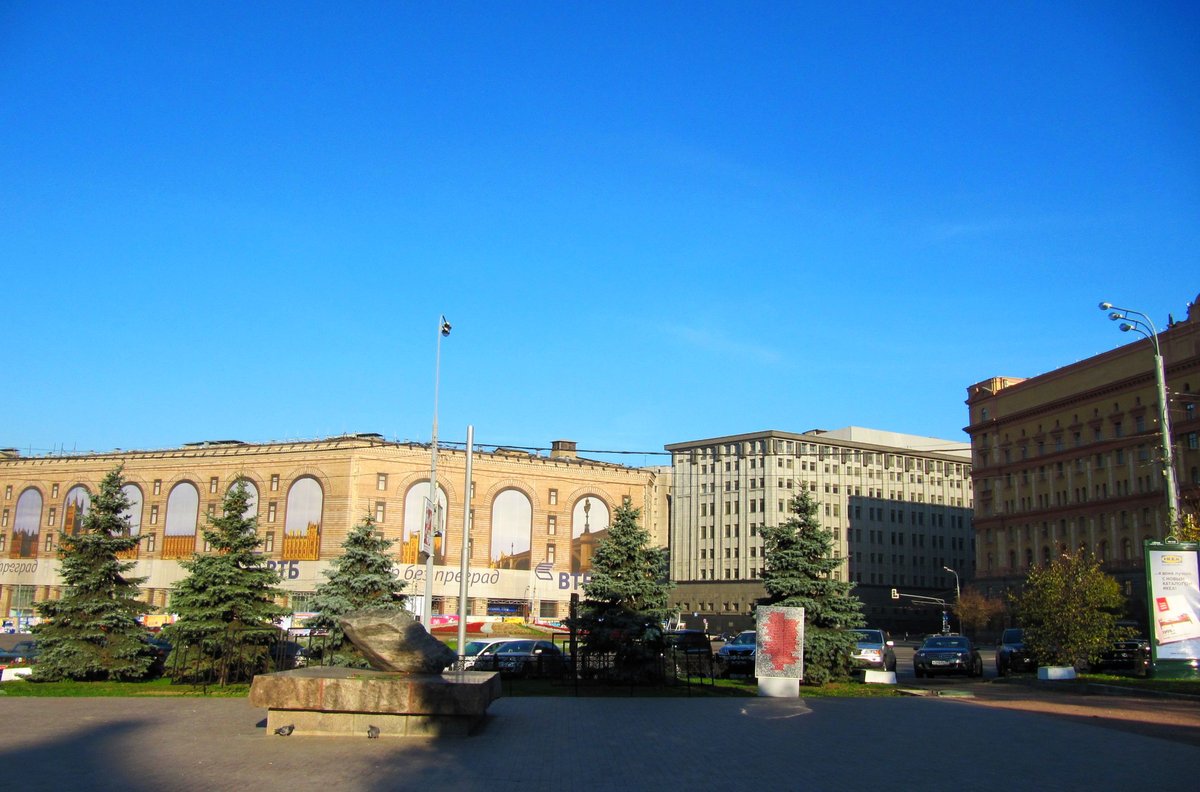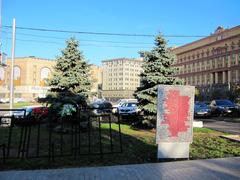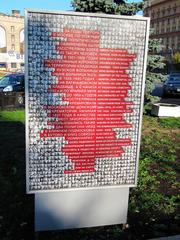
Visiting Solovetsky Stone in Moscow: Hours, Tickets, and Travel Tips
Date: 20/07/2024
Introduction
The Solovetsky Stone in Moscow stands as a powerful symbol of remembrance for the victims of Soviet-era political repression. This granite boulder, transported from the Solovetsky Islands—an archipelago notorious for its Soviet labor camps—offers visitors a poignant glimpse into Russia’s tumultuous past. Installed on October 30, 1990, in Lubyanka Square, the site holds immense historical and cultural significance. The choice of placing the stone opposite the former KGB headquarters underscores the stark contrast between the oppressive regime and those who suffered under it. Whether you are a history enthusiast or a casual visitor, the Solovetsky Stone serves as a solemn reminder of the resilience of the human spirit and the importance of remembering and learning from history. This guide aims to provide comprehensive information about the Solovetsky Stone, including its history, significance, and essential visitor information. (Memorial Society, KGB Museum).
Table of Contents
- Introduction
- History of Solovetsky Stone
- Visitor Information
- Political and Social Context
- Commemoration and Public Response
- Cultural and Artistic Representations
- Preservation and Maintenance
- Contemporary Relevance
- Nearby Attractions and Travel Tips
- Frequently Asked Questions (FAQ)
- Conclusion
History of Solovetsky Stone
Origins and Installation
The Solovetsky Stone is a poignant memorial located in Moscow, Russia. This monument is a granite boulder transported from the Solovetsky Islands, a site infamous for its Soviet-era labor camps. The stone was installed on October 30, 1990, in Lubyanka Square, directly opposite the former headquarters of the KGB, now the Federal Security Service (FSB) of Russia. This date was chosen to coincide with the Day of Remembrance of the Victims of Political Repressions, a significant day in Russian history dedicated to honoring those who suffered under Soviet repression.
The Solovetsky Islands and the Gulag System
The Solovetsky Islands, located in the White Sea, are historically significant as one of the earliest and most notorious sites of the Soviet Gulag system. The Gulag, an acronym for Glavnoe Upravlenie Lagerei (Main Camp Administration), was a network of forced labor camps established during Joseph Stalin’s rule. The Solovetsky Islands became a prototype for these camps, where political prisoners, intellectuals, and ordinary citizens were subjected to harsh conditions and forced labor.
The Solovetsky Stone serves as a stark reminder of the brutalities endured by millions of people. The stone itself, a silent witness to the suffering, was chosen for its symbolic connection to the Solovetsky Islands, making it a powerful emblem of remembrance and reflection.
Visitor Information
Solovetsky Stone Visiting Hours
The Solovetsky Stone is accessible to visitors 24/7. However, it is recommended to visit during daylight hours to fully appreciate the memorial and its surroundings.
Solovetsky Stone Tickets
There is no admission fee to visit the Solovetsky Stone, making it an accessible landmark for all.
Accessibility
The memorial is located in Lubyanka Square, which is easily accessible by public transport. The closest metro station is Lubyanka Station on the Sokolnicheskaya Line (Line 1).
Political and Social Context
The installation of the Solovetsky Stone in 1990 was a significant event in the context of the political changes occurring in the Soviet Union. This period marked the beginning of the end for the Soviet regime, characterized by Mikhail Gorbachev’s policies of glasnost (openness) and perestroika (restructuring). These reforms aimed to address the deep-seated issues within the Soviet system, including the acknowledgment of past atrocities.
The decision to place the Solovetsky Stone in Lubyanka Square was both symbolic and provocative. Lubyanka Square was synonymous with the KGB, an organization responsible for much of the political repression during the Soviet era. By placing the memorial in such a prominent and historically charged location, the organizers aimed to confront the past directly and ensure that the victims of political repression were not forgotten.
Commemoration and Public Response
Since its installation, the Solovetsky Stone has become a focal point for commemorative events and public gatherings. Every year on October 30, the Day of Remembrance of the Victims of Political Repressions, people gather at the stone to pay their respects. These events often include speeches, the laying of flowers, and moments of silence to honor the memory of those who suffered.
The memorial has also played a role in educational efforts, serving as a tangible reminder of the past for younger generations. Schools and universities often organize visits to the Solovetsky Stone as part of their history curriculum, ensuring that the lessons of the past are not forgotten.
Cultural and Artistic Representations
The Solovetsky Stone has inspired various cultural and artistic representations, reflecting its significance in Russian society. Numerous books, films, and artworks have been created to explore the themes of political repression and the Gulag system. One notable example is the book “The Gulag Archipelago” by Aleksandr Solzhenitsyn, which provides a detailed account of the Soviet labor camps and has become a seminal work in understanding this dark chapter of history.
Artists and sculptors have also drawn inspiration from the Solovetsky Stone, creating works that capture the emotional weight of the memorial. These artistic endeavors contribute to the ongoing dialogue about the importance of remembering and learning from the past.
Preservation and Maintenance
Maintaining the Solovetsky Stone and ensuring its preservation is a priority for various organizations and individuals. The stone is regularly cleaned and inspected to prevent damage and deterioration. Additionally, efforts are made to protect the site from vandalism and other forms of disrespect.
The preservation of the Solovetsky Stone is not only about maintaining a physical monument but also about preserving the memory and significance of the events it represents. This involves ongoing educational and commemorative efforts to keep the history alive and relevant.
Contemporary Relevance
In contemporary Russia, the Solovetsky Stone remains a powerful symbol of resistance against political repression and a reminder of the importance of human rights. It serves as a cautionary tale about the dangers of totalitarianism and the need for vigilance in protecting individual freedoms.
The memorial also highlights the ongoing struggles for historical memory and justice in Russia. Debates about how to remember and interpret the Soviet past continue to shape the country’s political and cultural landscape. The Solovetsky Stone stands as a testament to the resilience of those who suffered and a call to ensure that such atrocities are never repeated.
Nearby Attractions and Travel Tips
While visiting the Solovetsky Stone, take the opportunity to explore other historical sites in Moscow. Nearby attractions include the Kremlin, Red Square, and the State Historical Museum. These sites offer a deeper understanding of Russia’s rich history and cultural heritage.
Recommended Nearby Attractions
- The KGB Museum: Located in the former KGB headquarters, this museum offers a deep dive into the history of Soviet intelligence and security services. (KGB Museum)
- Polytechnical Museum: One of the oldest science and technology museums in the world, it features a vast collection of exhibits related to various scientific fields. (Polytechnical Museum)
- Red Square: A short walk from Lubyanka Square, Red Square is home to iconic landmarks such as the Kremlin, St. Basil’s Cathedral, and Lenin’s Mausoleum. (Red Square)
Frequently Asked Questions (FAQ)
Q: Is there an entry fee to visit the Solovetsky Stone?
A: No, visiting the Solovetsky Stone is free of charge.
Q: What are the visiting hours for the Solovetsky Stone?
A: The memorial is accessible 24/7, but it is recommended to visit during daylight hours.
Q: How can I get to the Solovetsky Stone?
A: The closest metro station is Lubyanka Station on the Sokolnicheskaya Line (Line 1).
Q: Are there guided tours available?
A: While there are no official guided tours specifically for the Solovetsky Stone, many tours of Moscow’s historical sites include a visit to the memorial.
Conclusion
The Solovetsky Stone in Moscow is more than just a memorial; it is a symbol of remembrance, reflection, and resilience. Its history, from the origins in the Solovetsky Islands to its installation in Lubyanka Square, encapsulates the complex and often painful history of political repression in Russia. Through ongoing commemoration, education, and preservation efforts, the Solovetsky Stone continues to serve as a powerful reminder of the past and a beacon of hope for the future. Plan your visit today to experience this significant historical site and pay tribute to those who suffered under Soviet repression. (Gulag History Museum, Red Square, Aleksandr Solzhenitsyn).
References
- Memorial Society. (n.d.). Retrieved from https://www.memo.ru/en-us/
- KGB Museum. (n.d.). Retrieved from https://www.tripadvisor.com/Attraction_Review-g298484-d300366-Reviews-KGB_Museum-Moscow_Central_Russia.html
- Gulag History Museum. (n.d.). Retrieved from https://www.gmig.ru/en/
- Red Square. (n.d.). Retrieved from https://www.moscovery.com/red-square/
- Solzhenitsyn, A. (1973). The Gulag Archipelago. Harper & Row. Retrieved from https://www.goodreads.com/book/show/70561.The_Gulag_Archipelago_1918_1956






















































































































































































































































































